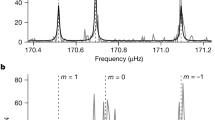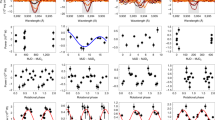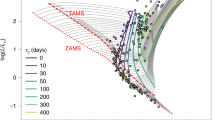Abstract
The magnetic fields of Earth and Jupiter, along with those of rapidly rotating, low-mass stars, are generated by convection-driven dynamos that may operate similarly1,2,3,4 (the slowly rotating Sun generates its field through a different dynamo mechanism5). The field strengths of planets and stars vary over three orders of magnitude, but the critical factor causing that variation has hitherto been unclear5,6. Here we report an extension of a scaling law derived from geodynamo models7 to rapidly rotating stars that have strong density stratification. The unifying principle in the scaling law is that the energy flux available for generating the magnetic field sets the field strength. Our scaling law fits the observed field strengths of Earth, Jupiter, young contracting stars and rapidly rotating low-mass stars, despite vast differences in the physical conditions of the objects. We predict that the field strengths of rapidly rotating brown dwarfs and massive extrasolar planets are high enough to make them observable.
This is a preview of subscription content, access via your institution
Access options
Subscribe to this journal
Receive 51 print issues and online access
$199.00 per year
only $3.90 per issue
Buy this article
- Purchase on Springer Link
- Instant access to full article PDF
Prices may be subject to local taxes which are calculated during checkout


Similar content being viewed by others
References
Donati, J.-F. et al. The large-scale axisymmetric magnetic topology of a very low-mass fully convective star. Science 311, 633–635 (2006)
Morin, J. et al. Large-scale magnetic topologies of mid-M dwarfs. Mon. Not. R. Astron. Soc. 390, 567–581 (2008)
Dobler, W., Stix, M. & Brandenburg, A. Magnetic field generation in fully convective rotating spheres. Astrophys. J. 638, 336–347 (2006)
Browning, M. Simulations of dynamo action in fully convective stars. Astrophys. J. 676, 1262–1280 (2008)
Charbonneau, P. Dynamo models of the solar cycle. Living Rev. Sol. Phys. 2, 2 (2005); 〈http://solarphysics.livingreviews.org/Articles/lrsp-2005-2〉 (cited on 13 November 2008)
Stevenson, D. J. Planetary magnetic fields. Earth Planet. Sci. Lett. 208, 1–11 (2003)
Christensen, U. R. & Aubert, J. Scaling properties of convection-driven dynamos in rotating spherical shells and applications to planetary magnetic fields. Geophys. J. Int. 166, 97–114 (2006)
Pizzolato, N., Maggio, A., Micela, G., Sciortino, S. & Ventura, P. The stellar activity-rotation relationship revisited: Dependence of saturated and non-saturated X-ray emission regimes on stellar mass for late-type dwarfs. Astron. Astrophys. 397, 147–157 (2003)
Reiners, A., Basri, M. & Browning, M. Evidence for magnetic flux saturation in rapidly rotating M stars. Astrophys. J. (in the press)
Sreenivasan, B. & Jones, C. A. The role of inertia in the evolution of spherical dynamos. Geophys. J. Int. 164, 467–476 (2006)
Olson, P. & Christensen, U. R. Dipole moment scaling for convection-driven planetary dynamos. Earth Planet. Sci. Lett. 250, 561–571 (2006)
Nimmo, F. in Treatise on Geophysics Vol. 8, Core dynamics (ed. Olson, P.) 31–66 (Elsevier, 2007)
Guillot, T. A comparison of the interiors of Jupiter and Saturn. Planet. Space Sci. 47, 1183–1200 (1999)
Granzer, T., Schüssler, M., Caligari, P. & Strassmeier, K. G. Distribution of star spots on cool stars. II. Pre-main-sequence and ZAMS stars between 0.4 Msun and 1.7 Msun . Astron. Astrophys. 355, 1087–1095 (2000)
Johns-Krull, C. M. The magnetic field of classical T Tauri stars. Astrophys. J. 664, 975–985 (2007)
Reiners, A. & Basri, G. The first direct measurements of surface magnetic fields on very low mass stars. Astrophys. J. 656, 1121–1135 (2007)
Bloxham, J. & Jackson, A. Time-dependent mapping of the magnetic field at the core-mantle boundary. J. Geophys. Res. 97, 19537–19563 (1992)
Connerney, J. E. P. Magnetic fields of the outer planets. J. Geophys. Res. 98, 18659–18679 (1993)
Saar, S. H. in Magnetodynamic Phenomena in the Solar Atmosphere (eds Uchida, Y., Kosugi, T. & Hudson, H. S.) 367–374 (Kluwer, 1996)
Christensen, U. R. A deep dynamo generating Mercury’s magnetic field. Nature 444, 1056–1058 (2006)
Stevenson, D. J. Saturn’s luminosity and magnetism. Science 208, 746–748 (1980)
Stanley, S. & Bloxham, J. Convective region geometry as the cause for Uranus’s and Neptune’s unusual magnetic fields. Nature 428, 151–153 (2004)
Burrows, A., Hubbard, W. B., Lunine, J. I. & Liebert, J. The theory of brown dwarfs and extrasolar giant planets. Rev. Mod. Phys. 73, 719–765 (2001)
Sanchez-Lavega, A. The magnetic field in giant extrasolar planets. Astrophys. J. 609, L87–L90 (2004)
Zarka, P. Plasma interactions of exoplanets with their parent star and associated radio emissions. Planet. Space Sci. 55, 598–617 (2007)
Lay, T., Hernlund, J. & Buffett, B. A. Core-mantle boundary heat flow. Nature Geosci. 1, 25–32 (2008)
Guillot, T., Stevenson, D. J., Hubbard, W. B. & Saumon, D. in Jupiter (eds Bagenal, F., Towling, T. E. & McKinnon, W. B.) 39–57 (Cambridge Univ. Press, 2005)
Neuhäuser, R., Sterzik, M. F., Schmitt, J. H. M. M., Wichmann, R. & Krautter, J. ROSAT survey observations of T Tauri stars in Taurus. Astron. Astrophys. 297, 391–417 (1995)
Baraffe, I. & Chabrier, G. Mass-spectral class relationship for M-dwarfs. Astrophys. J. 461, L51–L54 (1996)
Drilling, J. S. & Landolt, A. U. in Allen’s Astrophysical Quantities (ed. Cox, A. N.) 381–396 (Springer, 2000)
Acknowledgements
Reviews by C. Johns-Krull helped to sharpen the paper. U.R.C. thanks M. Rempel for prompting this study by asking if planetary scaling laws also apply to stars.
Author Contributions U.R.C. suggested the basic concept, performed dynamo simulations and wrote the paper. V.H. calculated stellar models. A.R. provided magnetic field data and other stellar data. All authors discussed results and commented on the manuscript.
Author information
Authors and Affiliations
Corresponding author
Supplementary information
Supplementary Information
This file contains Supplementary Methods, Supplementary Data, and Supplementary Tables 1-6 (PDF 191 kb)
PowerPoint slides
Rights and permissions
About this article
Cite this article
Christensen, U., Holzwarth, V. & Reiners, A. Energy flux determines magnetic field strength of planets and stars. Nature 457, 167–169 (2009). https://doi.org/10.1038/nature07626
Received:
Accepted:
Issue Date:
DOI: https://doi.org/10.1038/nature07626
This article is cited by
-
Simulations of Solar and Stellar Dynamos and Their Theoretical Interpretation
Space Science Reviews (2023)
-
An episodic high-intensity lunar core dynamo
Nature Astronomy (2022)
-
Fluid Dynamics Experiments for Planetary Interiors
Surveys in Geophysics (2022)
-
The origin and evolution of magnetic white dwarfs in close binary stars
Nature Astronomy (2021)
-
Magnetic fields of M dwarfs
The Astronomy and Astrophysics Review (2021)
Comments
By submitting a comment you agree to abide by our Terms and Community Guidelines. If you find something abusive or that does not comply with our terms or guidelines please flag it as inappropriate.



